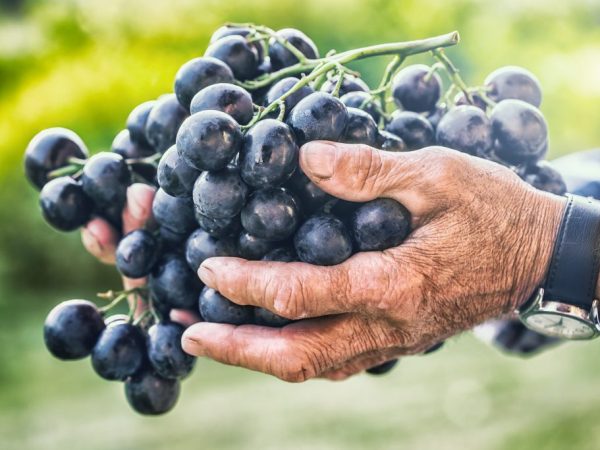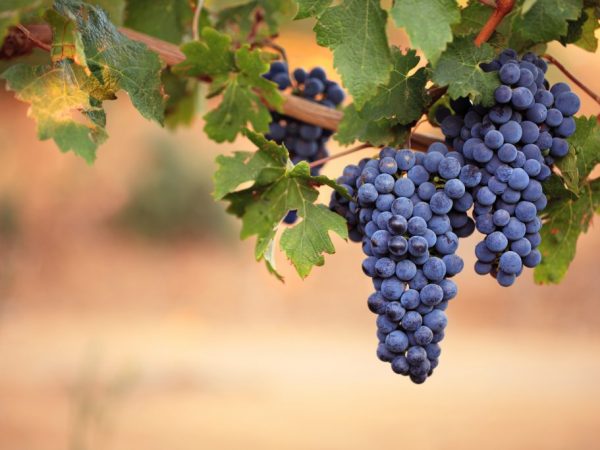The best technical grape varieties
For the production of wines, cognacs, compotes, technical grape varieties are used. They are distinguished by a high content (up to 85%) of juice in berries, as well as a harmonious taste. The sugar content of the fruit is high. They are also characterized by unpretentiousness and stable yield. New hybrids often match table varieties in taste.

The best technical grape varieties
Aligote
Aligote is an old variety originally from France. It is obtained by crossing Pinot Cepage and Gue Blanc. Widespread in Eastern Europe.
Ripening period is medium early. The fruits are harvested 145 days after the start of the growing season.
Aligote is not suitable for mechanized harvesting of fruits: the loss of juice is large. Recommended pruning is the multi-arm fan method. The seedlings have creeping shoots. Their tops are green with a bronze tint.
According to the description, the Aligote variety has the following positive characteristics:
- excellent profitability - 90-140 centners per hectare;
- unpretentious care;
- resistance to powdery mildew.
Negative qualities include the fact that Aligote is affected by mildew and gray rot, grape leafworm and spider mites. Although the species is relatively frost-resistant, the buds are often damaged by spring frosts.
Description of the bush
The plant is small. The number of fruitful shoots is 80-85%. The leaves are dark green, rounded. The edges are sharp, bent down. The petioles are wine-red.
Description of fruits
Bunches of cylindrical-conical shape, small size. Weight - about 100 g. The density is high. The peduncle is not long. The berries are round, 12-15 mm in diameter. Green-white at first, yellow-green at full maturity with tan spots and many brown spots. Are deformed by compression. The skin is thin but firm. The fruits have 1-2 seeds. The pulp is tender, juicy. The taste is simple and pleasant.
The berries crumble a little, which does not affect the cultivation result.
The average sugar content is 18%. Acidity - 7.5-10.4 g / l. Aligote technical grapes are excellent for winemaking, making juices, champagne.
Rondo
Rondo was bred by Czechoslovak and German breeders. His parents are Dawn of the North and Saint Laurent. This variety is grown in central Russia.
Ripens early. From the swelling of the buds to the full ripeness of the berries, 125-130 days pass. The fruits are harvested in mid to late August.
The variety has the following positive properties:
- excellent yield (especially when grown on black soil);
- immunity to disease;
- frost resistance: withstands temperatures up to -24 ° С;
- suitability for cultivation by amateurs.
Resistance to decay is high, but the fruits should be picked on time, otherwise they will dry out and fall off.
Description of the bush
The plant is vigorous. Reaches 10 m in height. Leaves are medium in size, trifoliate. In the fall, they take on a red color. The vine ripens well. Blooms in mid-June. The flowers are unattractive, yellow, bisexual. Pollination is good. The optimal load is 30-35 eyes.Pruning of fruitful vines is carried out for 3-5 eyes. Technical grapes, good rooting of cuttings.
Description of fruits

Berries have a cherry flavor
The clusters are conical in shape, their size is small. Weight - 120-300 g. Average density. The berries are round, medium, weight - up to 3 g. The skin is dense, medium thickness. The color is black. The pulp is juicy, purple-black. The taste is pleasant, with hints of cherry.
Sugar content - up to 18-21%. Acidity - 9-10 g / l. The fruits are suitable for the preparation of high quality, highly acidic wines that are stored in barrels for a long time.
Crystal
Kristall is a technical Hungarian grape variety. It is obtained by crossing the Amurskiy, Villar Blanc, Challozi Lajos species. Represents non-covering species. Suitable for growing in the Moscow region.
Ripens early. From the beginning of the growing season to the phase of fruit ripening, 110-115 days pass. Fruits begin to be harvested from mid-August.
Among the positive characteristics of the variety are:
- high productivity;
- resistance to low temperatures: withstands indicators up to -29 ° С;
- immunity to powdery mildew, downy mildew, gray mold;
- excellent survival rate of seedlings;
- undemanding care.
It is worth monitoring the thickening of the canopy of the bush, otherwise the ovaries will begin to crumble, the clusters will become disheveled. As a result, yields will decrease.
Description of the bush
The culture is medium-sized. Leaves are dark green, medium-sized, strongly cut. The flowers are bisexual. Young shoots are reddish. Ripening of shoots - 85-90%. The optimal load is 60 eyes per bush with a length of 3-4 eyes for pruning fruit vines.
Description of fruits
Bunches are cylindrical-conical or conical, weighing up to 200 g, dense. Berries are oval, yellow-green, sometimes white, with a waxy coating. Weight - up to 2 g. The skin is thin. The pulp is tender honey, juicy.
It accumulates sugar up to 23% (on average - 18%). Acidity - up to 6 g / l. Juice yield - 70%.
The variety is used in winemaking: white table wine is produced.
Regent
Regent is one of the best technical grape varieties. He is originally from Germany. Parents - Diana and Chamboursen. Represents non-covering species. But in the regions of Moscow, Tver, it should be sheltered.
Has a medium late ripening period. From swelling of the buds to full maturity of the fruit, 130-140 days pass. The fruits are enjoyed at the end of September. Yield indicators are average, depending on the region of cultivation.

Fruits must be picked on time
According to the description, the Regent has the following positive properties:
- frost resistance: withstands temperatures of -27 ° C-28 ° C;
- rapid ripening of shoots;
- good rooting of seedlings;
- immunity to gray rot, oidium, mildew and phylloxera.
If the fruits are not picked in time, they begin to crumble and lose their acidity. The variety is sensitive to nutrient deficiencies in the soil, especially magnesium. Differs in exacting care. It is not recommended for growing in the northern regions, since the fruits may not have time to ripen.
Description of the bush
The plant is small (up to 4 m), highly branching. The branches are strong and wide. Leaves are medium or large, rich green. The edges are serrated, the veins are light. Fruiting shoots 80%. Pruning is carried out at the level of 3-4 eyes. The optimal load on the bush is 60-80 eyes.
Description of fruits
The clusters are cylindrical-conical, small. Weight - 160-185 g. Average density. The berries are round. The color is dark blue, almost black. Weight - 1.5 g. The skin is thin. The pulp is juicy, blue-violet, has an aroma of herbs and nutmeg.
The sugar content of the fruit is 22%, the acidity is 8 g / l. The variety is used in winemaking, high-quality red table wines are obtained from berries, compotes and juices are prepared.
Conclusion
When growing technical grape varieties, a mechanized cultivation method is often used. For the Moscow region and middle regions, the following types are perfect: Isabella, Lydia, Alpha.
Technical grape varieties suitable for the Central Black Earth Region and the South - Muscat Moskovsky, Cardinal, Madeleine Angevin, etc. For the North - Sharov's Riddle, Timur, Russian Early, Black Sweet.
Table and technical grape varieties are distinguished by the chemical composition of the berries. Gardeners do not consider the external qualities of the fruit. They are popular for their balanced sugar and acid content.


